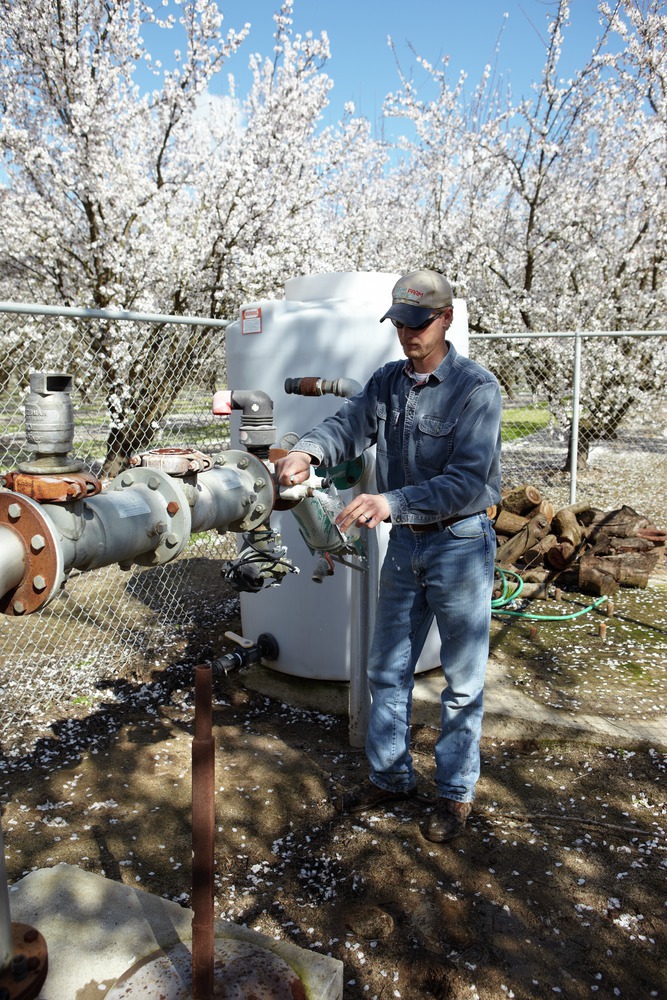(Jan. 24, 2020) – “It has never been a more challenging time to be a grower in California, given the breadth of regulations we face,” said Jesse Roseman during The Almond Conference 2019 session “Research Update: Nutrient Management.”
 “Plant nutrition is no longer simply about maximizing productivity – it’s increasingly about dealing with regulations. We’re under pressure to manage nitrogen,” said UC Davis professor Patrick Brown at The Almond Conference 2019.
“Plant nutrition is no longer simply about maximizing productivity – it’s increasingly about dealing with regulations. We’re under pressure to manage nitrogen,” said UC Davis professor Patrick Brown at The Almond Conference 2019.
Roseman, principal analyst for Regulatory and Environmental Affairs at the Almond Board of California (ABC), joined key experts onstage at the industry’s annual conference to share a stark reality with almond growers – nitrogen management within almond orchards will became even more complicated this year.
The Central Valley Regional Water Quality Control Board is expanding its number of water quality coalitions that require growers to report irrigation methods in addition to nitrogen management. New requirements for drinking water and well testing will also expand.
The goal of these programs is to optimize nutrient efficiency in the orchard to reduce water quality threats to the aquifers below.
“Plant nutrition is no longer simply about maximizing productivity – it’s increasingly about dealing with regulations. We’re under pressure to manage nitrogen,” stressed UC Davis professor Patrick Brown, who specializes in almond nutrient management.
INMP: what it means, where to start
As part of increased reporting, growers in all coalitions will need to prepare an Irrigation Nutrient Management Plan (INMP) for all acreage. An INMP should include how much nitrogen is applied from all sources (including irrigation water), estimated crop yield, an estimate of the nitrogen removed and details about irrigation management (method, volume, ET and efficiency practices).
Growers can find resources, including an INMP template, on the Central Valley Regional Water Quality Control Board website, which also provides additional information on the Irrigation Lands Regulatory Program (ILRP), under which INMPs are required.
Fortunately for growers who participate in ABC’s California Almond Sustainability Program (CASP), Roseman said those who have completed the Irrigation Management module as well as the Nutrient Management module will have compiled much of the data needed for their INMP.
INMPs must be completed and kept on file at growers’ operational headquarters no later than June 15, 2020. The plans must be certified by a Certified Crop Advisor who has taken the nitrogen management class from the California Department of Food and Agriculture. Growers can take a self-certification class to certify their own plans.
These plans are part of a long-term effort to protect groundwater supplies. Across the state, Water Quality Coalitions – which include growers – also must develop Groundwater Protection Targets within each groundwater sub-basin to identify how much nitrogen can be safely applied based on the leaching potential of that region’s conditions. The coalitions have 20 years to develop their plans.
Growing in California
The attention on nitrogen levels comes at a time when California has put a premium on safe drinking water. The state passed a law in 2012 giving residents the right to clean water. Last year, legislators went a step further, creating a fund to help provide clean drinking water.
Roseman said an estimated one million people – many of them in the San Joaquin Valley – are threatened by poor water quality. The state’s objective through increasing legislation and regulation, therefore, is to provide safe drinking water, including reducing nitrate and salt loading into aquifers, and ultimately restore water quality in aquifers used by agriculture.
However, solutions to poor water quality will not be borne by agriculture alone, Roseman said, as under the Central Valley Salinity Alternatives for Long-term Sustainability (CV-SALTS) program cities and other industries are also involved. Pilot programs to coordinate management with non-agricultural groups to monitor wells and groundwater supplies and to provide substitute drinking water supplies already exist in areas near Turlock and in Merced and Fresno counties.
Stay tuned for more information on regulatory updates as well as nutrient management tips for optimum production in future issues of “In the Orchard.”